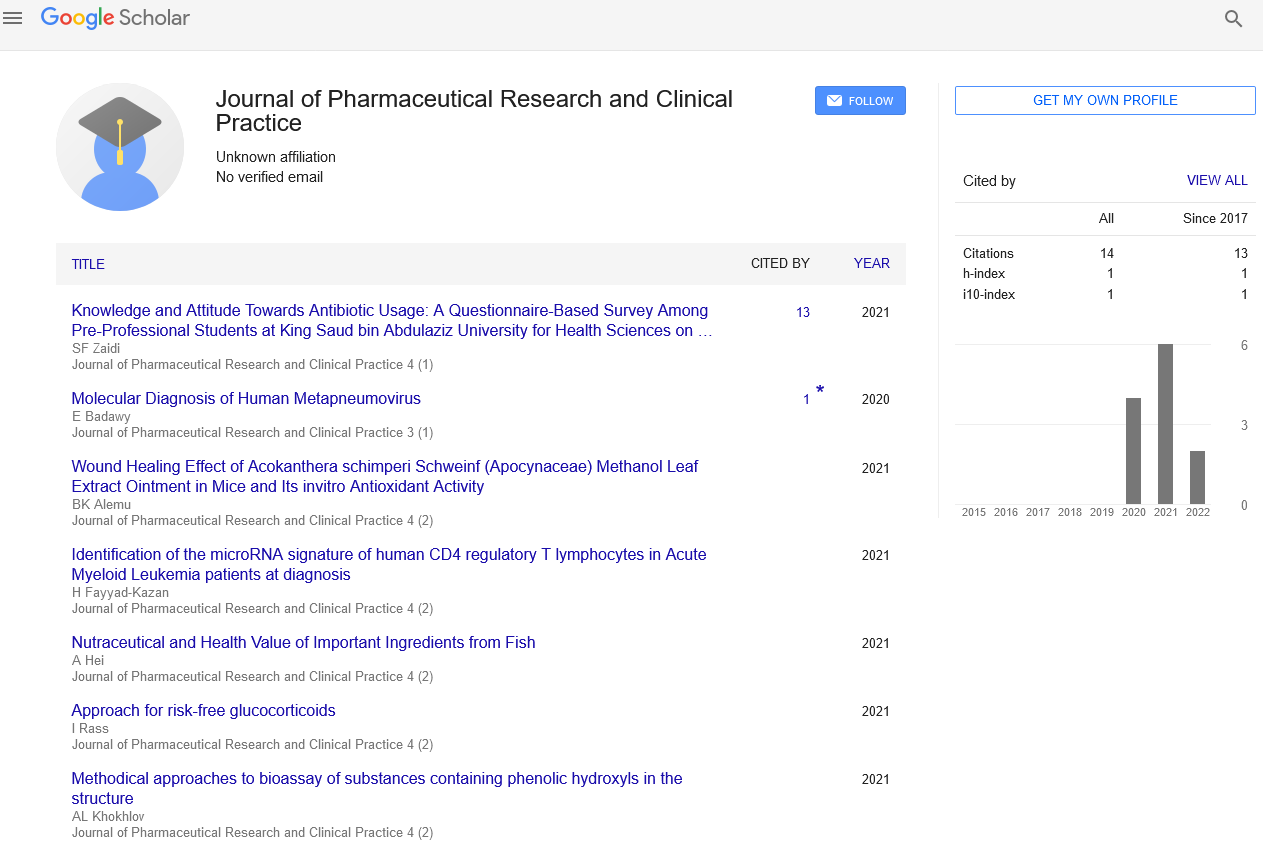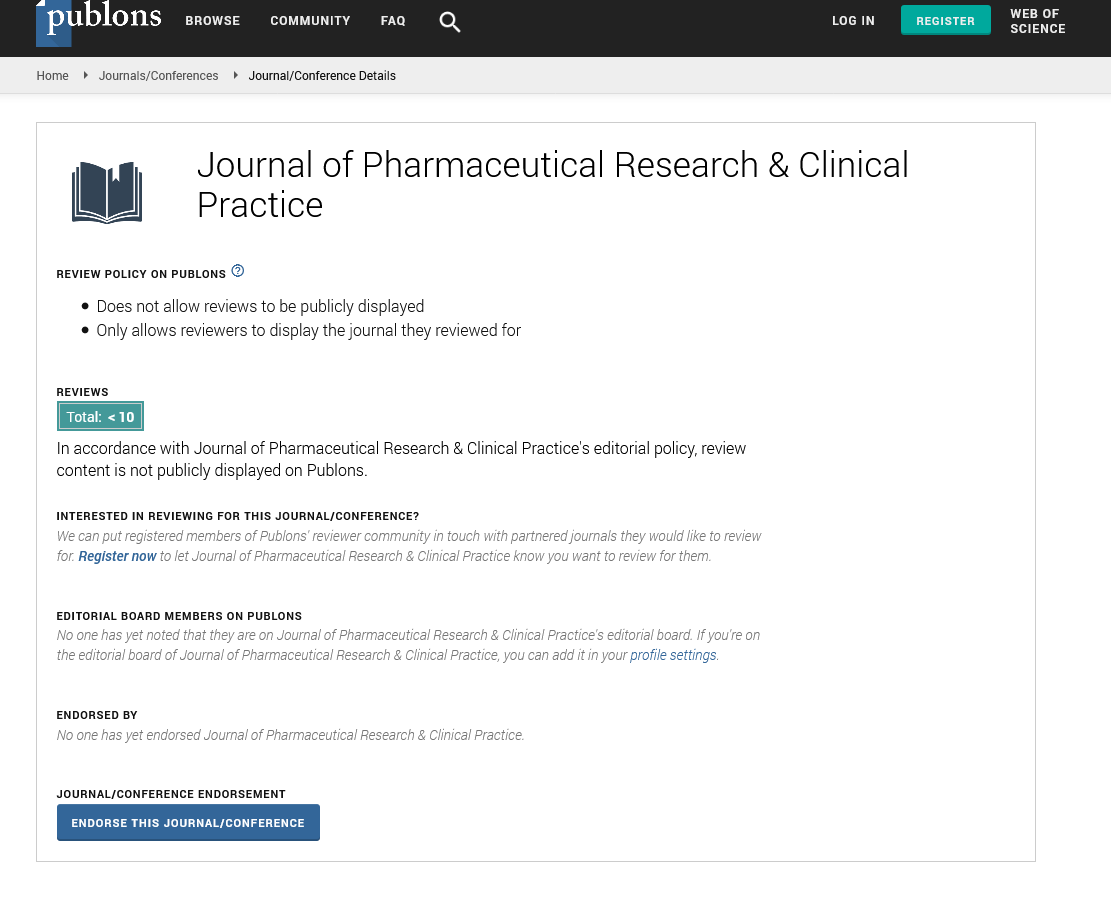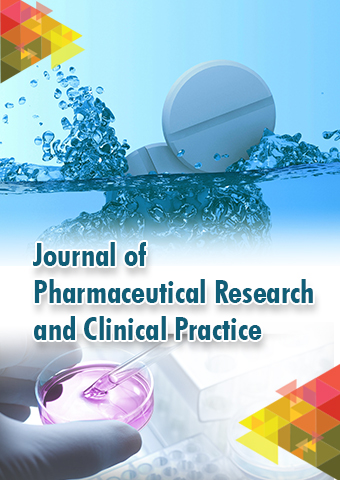Short Article - Journal of Pharmaceutical Research and Clinical Practice (2020) Volume 3, Issue 2
A Green Approach for Small Leads
Mantha Saraswathi Sowmya
College of Pharmaceutical Sciences, Andhra University, Visakhapatnam, India
Abstract
A novel process of one-pot synthesis of halogenated (benzimidazole (1yl) phenyl methanone derivatives by the assistance of microwave irradiation. Apart from conventional synthetic methods (MWAS) is one of the promising techniques that is been employed in the field of organic chemistry. It is known to be more productive when compared to the other methods, it is a very simple method that removes the overheating and boiling of solvents which are been taken as the candidates for the study. By this method the yield can be doubled than before, it enhances the molar efficiency of the components, this process reduces the time and minimizes the usage of chemicals, this method is a purely closed process through which it can endure the environment free of chemicals which ultimately leads "GREEN CHEMISTRY".
INTRODUCTION
In this article, we will be focusing on the benzimidazole molecule as a

atoms as the heteroatom, due to this nitrogen it always acts as a nucleophile and the pi-electron cloud delocalized electron system plays a crucial role in its biological activity.
Imidazoles and benzimidazole both are abundantly found in nature as well as in our physiological systems like hemoglobin, vitamin B121, purines, DNA. “amide”, these amides are Schiff bases most privileged chemical scaffolds they have shown prominent therapeutical indications like antimicrobial (bactericidal, fungicidal), antiprotozaol, antitumor, antiulcer, anti-inflammatory2 actions, antidiuretic activity4.
Why imidazoles: Public health concerns about microbial infection as they invade, multiply, manifest in the host, these cause a significant amount of discomfort to public health.These microbial infections are creating a global burden, it increases both the mortality rate and the morbidity, elevates the prevalence of diseases.
Alarming raises in infections seen in pandemic situations, and they are also sometimes inevitable to patients, noscomial, contagious.
METHODOLOGY
Here I performed the methods which are nonconventional and for primer (benzimidazole) using conventional

Orthophenelene diamine is a starting material and which condensed with 2- substituted acids and allows to go for 8 hours of reflux and continuous monitoring of the reaction mixture by thin-layer chromatography, after the completion of the reaction is further proceed to work up purification reaction mixture separation and isolation of candidate of interest.
Preparation of benzimidazole8:
92.47m.mols of (10gm) orthophenylene diamine taken in a 250 ml Rbf add (110.9672 m.mol) 5.2 ml of 90% formic acid. Heat the mixture in a water bath at 1000C for 2 hours. Cool the mixture and add 10%NaOH drop wise until the solution turns alkaline. wash with cold water drain well again wash with cold water. The resultant mixture was filtered, the crude benzimidazole dissolved in boiling water and add 8gms of decolorizing agent digest for 15min. Filter the mixture rapidly throw pre heated Buchner pump. Cool the solid product at 100C and then dried at 1000C. 50% yield was obtained with 1740C melting point. This product is directly used in the next step without further purification.
General synthetic procedure for (1H-benzimidazole-1-yl)(2phenyl) methanones:
1mol of Benzimidazole and 2-methyl benzimidazole accurately weighed and taken into microwave-assisted7 vials and add 1.5moles of various substituted benzoyl chlorides and trace amounts of triethylamine in an accurate way sealed with crimp machine placed in MW. Triethylamine was added to trap hydrogen chloride. Reaction conditions are at 1000C and 100Wpower,3 bar presser for 1 minute.
1H-benzo[d]imidazol-1-yl)(phenyl)methanone(1):(1.69m mol ) 200 mg benzimidazole react with (2.54mmols) 355mg,11.75ml benzoyl chloride.
1H-benzo[d]imidazol-1-yl)(2-fluorophenyl)methanone(2): (1.69m mol) 200mg benzimidazole react with (2.54mmols) 401mg,12.32ml of 2- fluoro benzoyl chloride. By using this procedure a series of compounds were synthesized and purified.
Spectral Characterization of compounds:

Biological screening:
Evaluation of antimicrobial activity
a) Preliminary screening
1. Antibacterial activity
2. Antifungal activity
3. Anti TB activity
Antibacterial studies: Antibacterial activity of benzimidazole6 methanones due to the presence of imidazole and these are halogen-substituted derivatives, chlorine fluorine nitroso electron withdrawal capacity of functional groups mainly put forward the antifungal and antibacterial activity. Our candidates have shown gram-positive and gram-negative bactericidal activity.
Antibacterial studies are carried by one of the standard Indian pharmacopeial Agar cup plate methods
Standard microorganism: A model bacterium, gram-positive bacillus subtilis Standard control: amikacin
Qualitative measure: zone of inhibition in mm.
Antifungal activity: Potato dextrose agar medium (PDA): It is a basal medium for cultivation, identification and enumeration of fungal, all these microbes are devastating the globe in one another way they are micro creatures can’t even see by the naked eye but they have shown adverse effects and indications. These microbes co-exist within the basic human needs such as the food we take, the water we consume, and randomly contaminate public health.
Standard drug: fluco azole
Standard fungal inoculum: aspergillus Niger
Qualitative estimation: by scaling the zone of inhibition.
RESULTS AND CONCLUSION
•Synthesized compounds were (50μg/ml) screened for Anti-microbial activity by cup plate method against the organisms B.subtilis andA.niger
•Most of the synthesized compounds exhibited moderate to good anti-microbial activity against tested microorganisms.
•When compared to standard drug (amikacin and fluconazole for anti-bacterial and anti-fungal respectively) 2BI,A,2FA,,35NA,2M2FA,2M3F were found to exhibit good anti-microbial activity (1H-benzo[d]imidazol-1-yl)(2-fluorophenyl)methanone
•In the present study, benzimidazole derivatives were synthesized and characterized by IR, Mass, and NMR Spectral data.
•Compounds were screened for anti-microbial activity (50μg/μl) by cup
•Anti-bacterial activities of the synthesized compounds were tested against B.subtilis and Anti-fungal activities of the compounds were tested against A. niger.
•All compounds exhibited moderate to potent anti-microbial activity. Compounds were active against all tested micro-organisms.
•The compound 2FA was found to be exhibit maximum anti-bacterial activity (Zone of inhibition 26mm.) when compared with standard drug B.subtilis (Zone of inhibition 36mm) given at a concentration of 50μg/50μl.
•The compound 2FA, was found to be exhibit maximum anti-fungal activity (Zone of inhibition 28mm.) when compared with standard drug A.niger (Zone of inhibition 32mm) given at a concentration of 50μg/50μl.2FA
After the full-fledged study we anticipate that halogenated meta substituted electron withdrawal groups of benzimidazole3 derivatives shown high impact on antimicrobial activity, chlorine and fluorine substituted benzimidazoles shown fruitful results.
FURTHER STUDIES:
I’ll think that these super small heterocyclics might be produced antitumor antiviral5 activites as well, so my further future extensions will be on that way.


